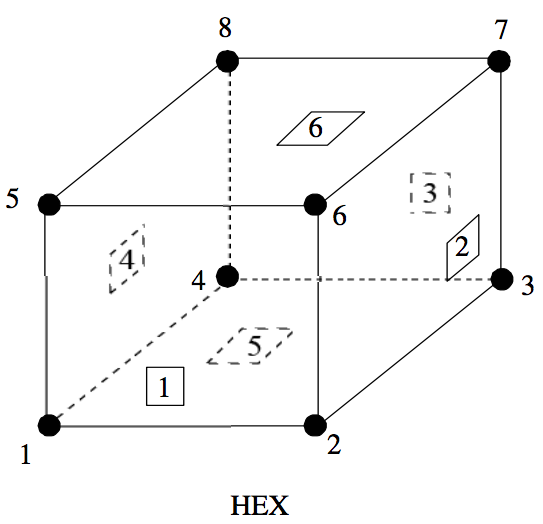Element Types
The following table shows the element types supported in the Exodus library, the IOSS library, nem_slice, and nem_spread.
| Element | Nodes | Exodus | IOSS | nem_slice | nem_spread |
|---|---|---|---|---|---|
| circle | 1 | X | X | X | X |
| sphere | 1 | X | X | X | X |
| beam | 2 | X | X | X | X |
| 3 | X | X | X | X | |
| 4 | X | X | |||
| quad | 4 | X | X | X | X |
| 5 | X | ||||
| 8 | X | X | |||
| 9 | X | X | X | X | |
| 12 | X | X | |||
| 16 | X | X | |||
| tri (2D) | 3 | X | X | X | X |
| 4 | X | X | X | X | |
| 6 | X | X | X | X | |
| 7 | X | X | X | X | |
| 9 | X | X | |||
| 13 | X | X | |||
| tri (3D) | 3 | X | X | X | X |
| 4 | X | X | X | X | |
| 6 | X | X | X | X | |
| 7 | X | X | X | X | |
| 9 | X | X | |||
| 13 | X | X | |||
| shell | 2 | X | X | X | X |
| 3 | tri3 | X | X | X | |
| 4 | X | X | X | X | |
| 8 | X | X | X | X | |
| 9 | X | X | X | X | |
| tet | 4 | X | X | X | X |
| 5 | X | ||||
| 7 | X | ||||
| 8 | X | X | X | X | |
| 10 | X | X | X | X | |
| 11 | X | X | |||
| 14 | X | X | X | X | |
| 15 | X | X | X | X | |
| 16 | X | X | |||
| 40 | X | X | |||
| pyramid | 5 | X | X | X | X |
| 13 | X | X | X | X | |
| 14 | X | X | X | X | |
| 18 | X | X | X | X | |
| 19 | X | X | X | X | |
| wedge | 6 | X | X | X | X |
| 12 | X | X | X | X | |
| 15 | X | X | X | X | |
| 16 | X | X | X | X | |
| 18 | X | X | |||
| 20 | X | X | X | X | |
| 21 | X | X | X | X | |
| 24 | X | X | |||
| 52 | X | X | |||
| hex | 8 | X | X | X | X |
| 9 | X | X | |||
| 16 | X | X | X | X | |
| 20 | X | X | X | X | |
| 27 | X | X | X | X | |
| 32 | X | X | |||
| 64 | X | X |
Only the base topology name is required for the element type. For example, all elements of a hex topology can be referred to by the name hex no matter how many nodes there are. However, it is also correct to append the node count to the topology type for the element name. For example, a 20-node hex could be named hex20.
The IOSS library, nem_slice, and nem_spread cannot correctly handle a mesh unless it contains elements of a known type.
However, the exodus library can store elements of an unknown type with a few limitations. For an unsupported element type, the exodus library will not:
- return the side set node list.
- return the side set node list node count.
- convert side set nodes to sides or vice versa.
If none of the above functions are required, then an element unknown to the exodus library can can be written to and read from an exodus file with no loss of information.
Exodus Node Ordering Convention
Node ordering follows the conventions illustrated in the figures below. The node ordering conventions follow the element topology used in PATRAN. Thus, for higher-order elements than those illustrated, use the ordering prescribed in the PATRAN Element Library Manual Manual https://web.mscsoftware.com/training_videos/patran/reverb3/index.html#page/Finite%2520Element%2520Modeling/elem_lib_topics.16.1.html#ww33606.
Circle and Sphere
For elements of type circle or sphere, the topology is one node at the center of the circle or sphere element. A circle or sphere element has no sides.


Bar, Truss, Beam
The element name for this element type can be "bar", "beam", "truss". For the "beam", the boundaries are the "top" and "bottom" edges; for the "bar" or "truss", the boundaries are the end nodes.


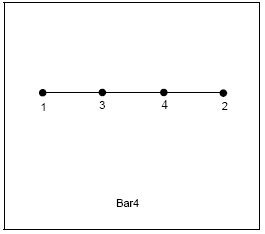
Triangular
These are usable in 2D or 3D meshes. In a 3D mesh, they would represent triangular shells. The element name is "triangle" or "tri" in either case.
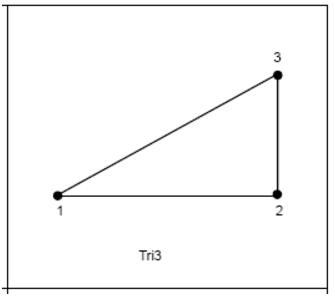
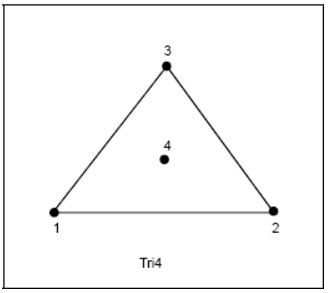
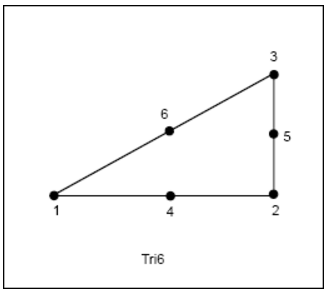
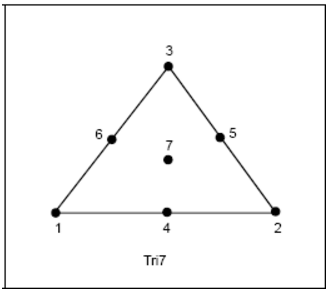
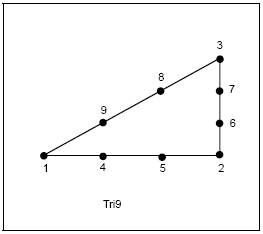
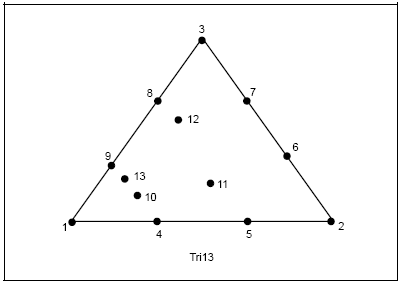
The side numbering for a tri element is shown below. For a triangular shell, there are five sides. Side 1 is the "top" of the triangle given by nodes 1-2-3 and side 2 is the "bottom" of the triangle given by nodes 3-2-1. Sides 3,4,5 correspond to sides 1,2,3 of the 2D triangle.
| Element Type | Side # | Node Order |
|---|---|---|
| TRI (2D) | 1 | 1, 2 |
| 2 | 2, 3 | |
| 3 | 3, 1 |
| Element Type | Side # | Node Order |
|---|---|---|
| TRI (3D) | 1 | 1, 2, 3 |
| 2 | 1, 3, 2 | |
| (Edges) | 3 | 1, 2 |
| 4 | 2, 3 | |
| 5 | 3, 1 |
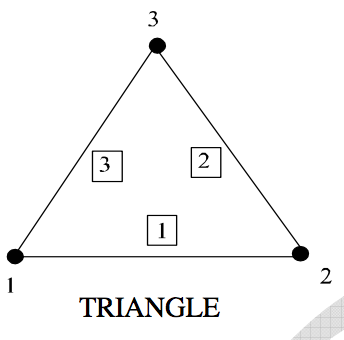
Quadrilateral
These are usable in 2D or 3D meshes. In a 3D mesh, they represent a quadrilateral shell element and the element name is "shell"; in a 2D mesh, the element name is "quad".
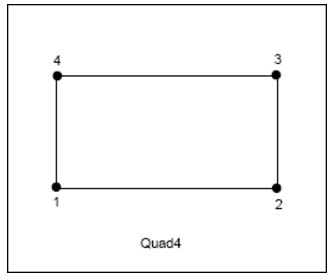
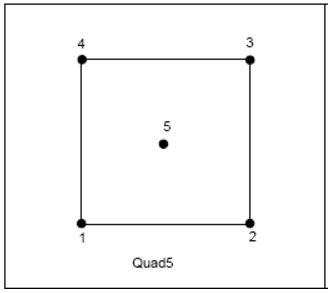
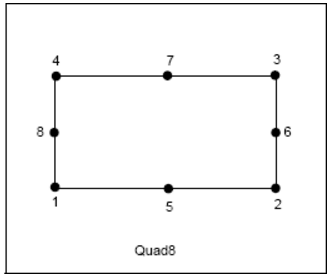
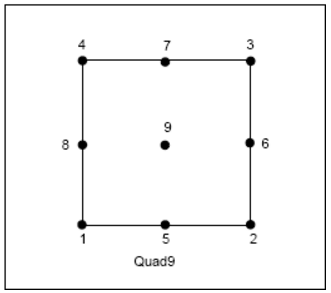
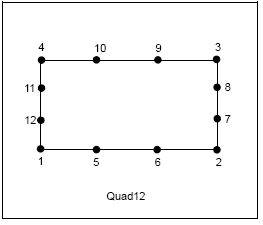
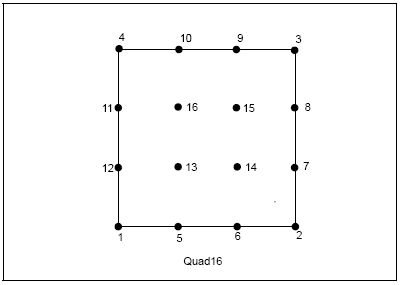
The side numbering for a 2D quadrilateral element and a 3D quadrilateral shell element are shown below.
| Element Type | Side # | Node Order |
|---|---|---|
| QUAD (2D) | 1 | 1, 2 |
| 2 | 2, 3 | |
| 3 | 3, 4 | |
| 4 | 4, 1 |
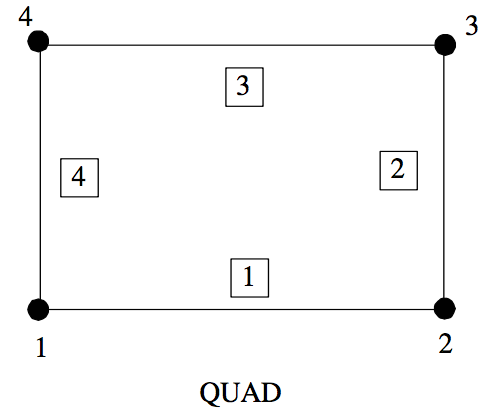
| Element Type | Side # | Node Order |
|---|---|---|
| SHELL (3D) | 1 | 1, 2, 3, 4 |
| 2 | 1, 4, 3, 2 | |
| (Edges) | 3 | 1, 2 |
| 4 | 2, 3 | |
| 5 | 3, 4 | |
| 6 | 4, 1 |
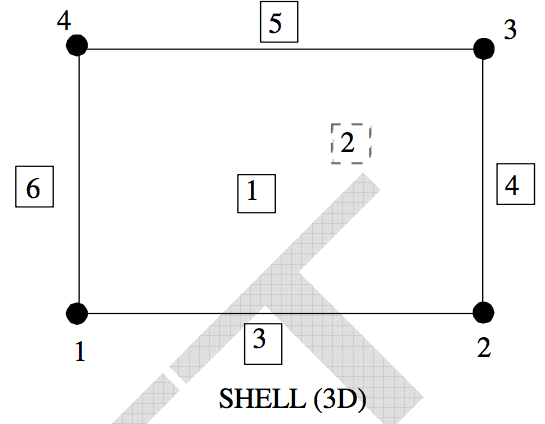
Tetrahedral
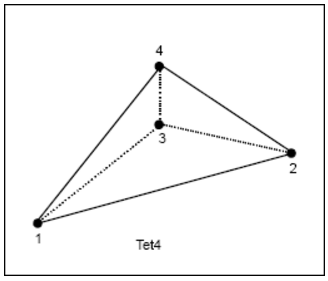

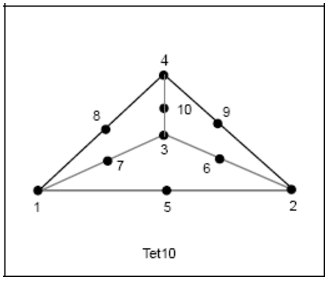
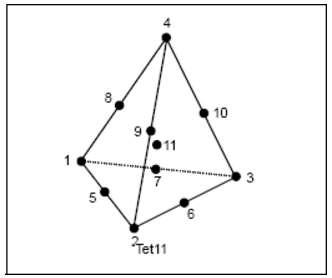
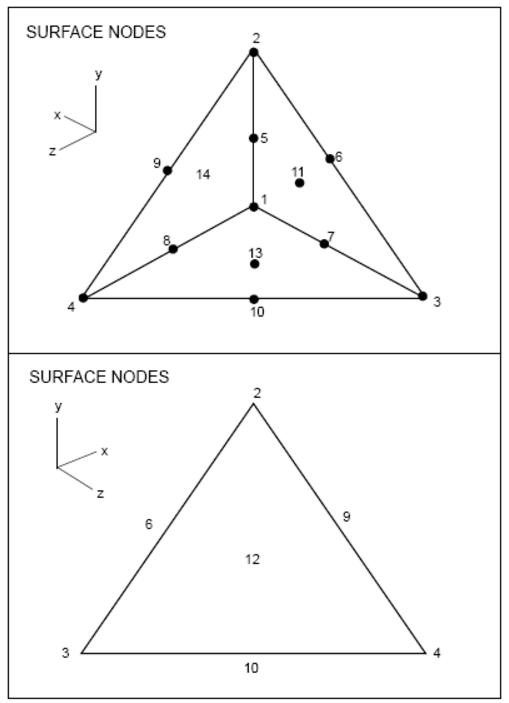
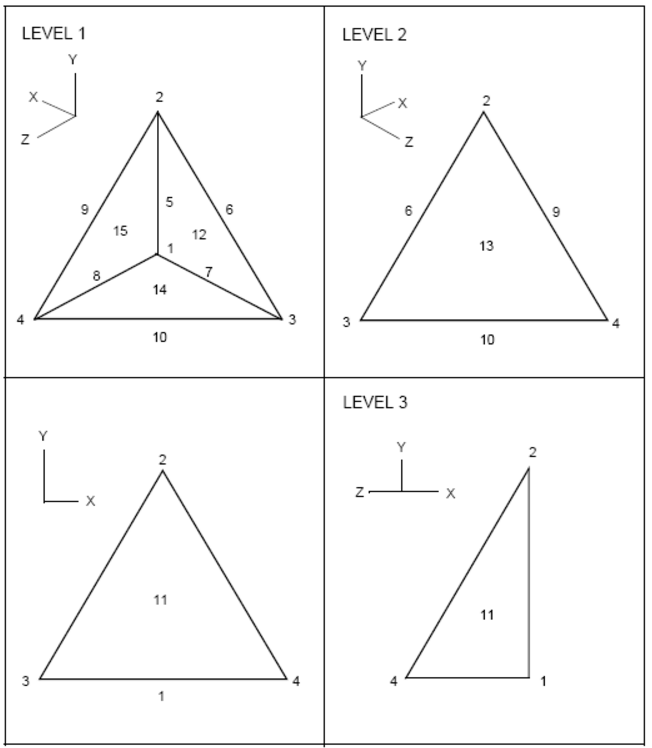
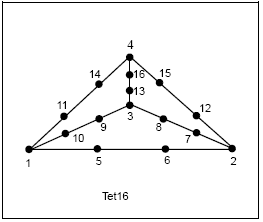
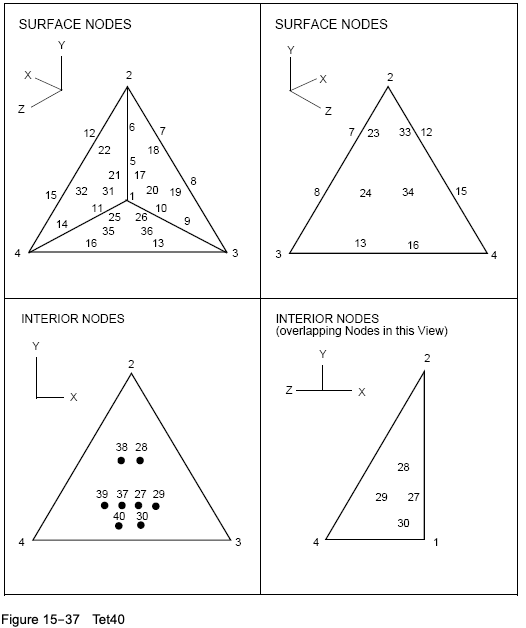
The side numbering for a tetrahedral element type is shown below.
| Element Type | Side # | Node Order |
|---|---|---|
| TETRA | 1 | 1, 2, 4 |
| 2 | 2, 3, 4 | |
| 3 | 1, 4, 3 | |
| 4 | 1, 3, 2 |
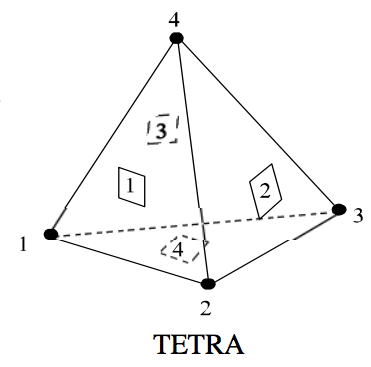
Pyramidal

The pyramid18 adds mid-face nodes to the triangular faces and the pyramid19 adds a mid-volume node.
The side numbering for a pyramidal element type is shown below.
| Element Type | Side # | Node Order |
|---|---|---|
| PYRAMID | 1 | 1, 2, 5 |
| 2 | 2, 3, 5 | |
| 3 | 3, 4, 5 | |
| 4 | 4, 1, 5 | |
| 5 | 1, 4, 3, 2 |

Wedge
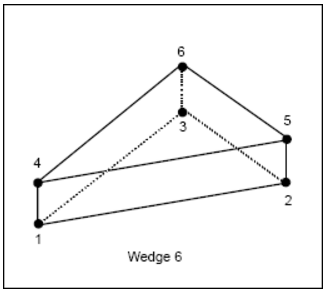
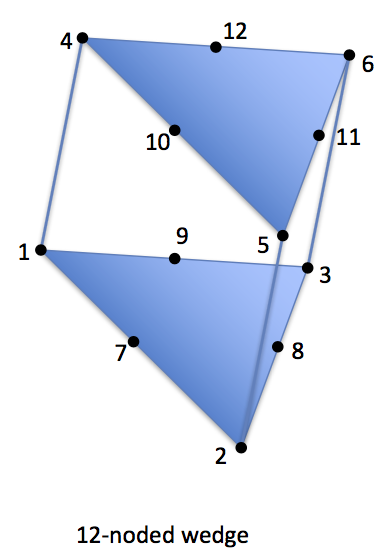
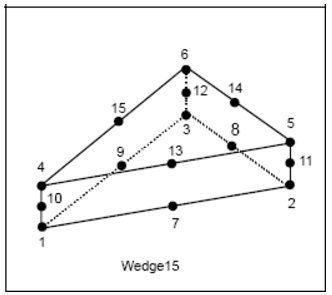
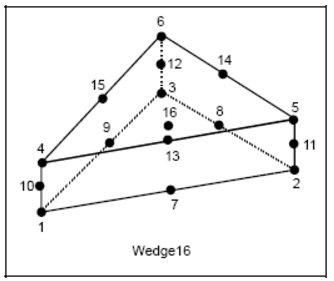
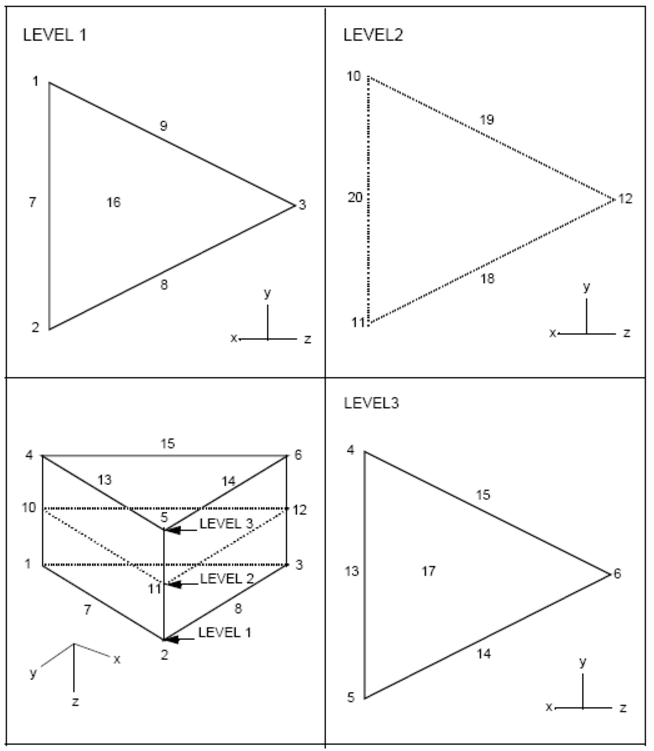
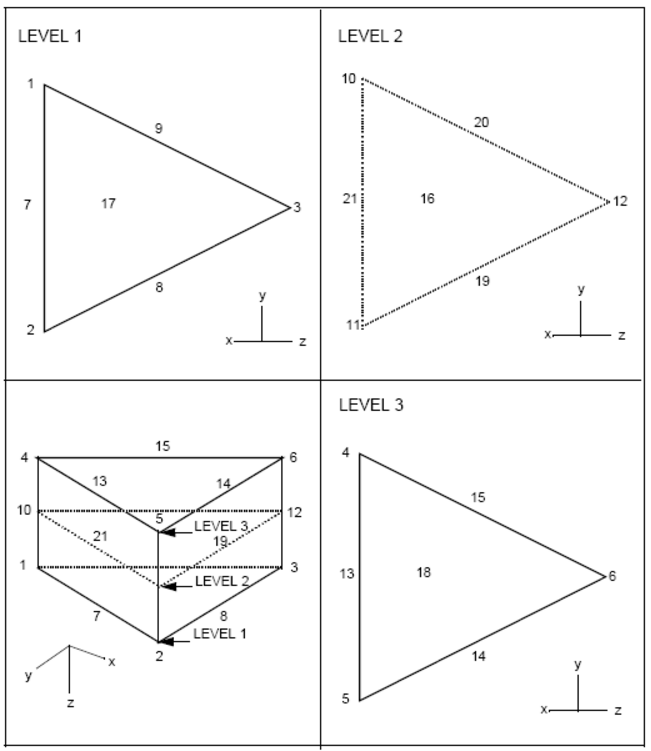
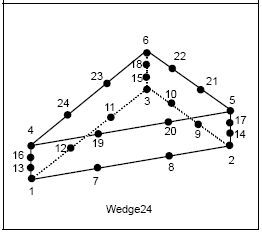

The side numbering for a wedge element type is shown below. Note that the face mapping for this element does not match the MSC/Patran face mapping. In exodus, sides 1,2,3 are quadrilateral and sides 4,5 are triangular; in MSC/Patran, sides 1,2 are triangular and sides 4,5,6 are quadrilateral. It is unclear when and why this digression occurred.
| Element Type | Side # | Node Order | Patran Side |
|---|---|---|---|
| WEDGE | 1 | 1, 2, 5, 4 | 3 |
| 2 | 2, 3, 6, 5 | 5 | |
| 3 | 1, 4, 6, 3 | 4 | |
| 4 | 1, 3, 2 | 1 | |
| 5 | 4, 5, 6 | 2 |
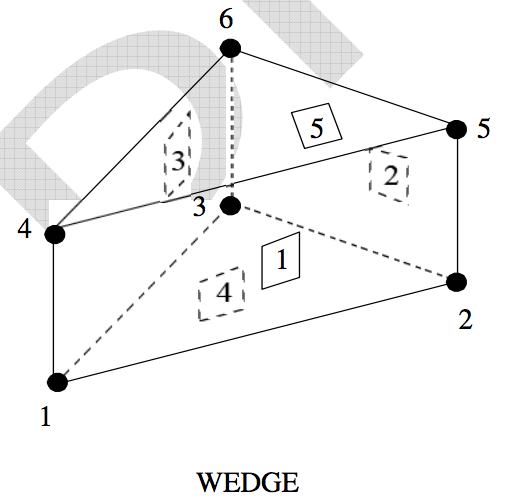
Hexahedral
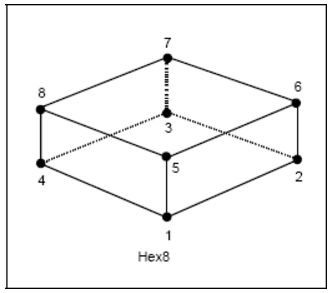
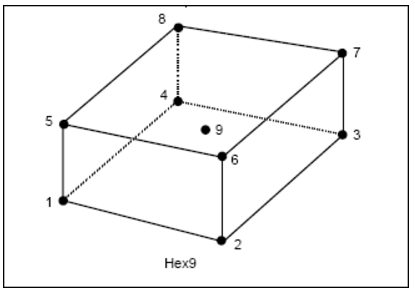
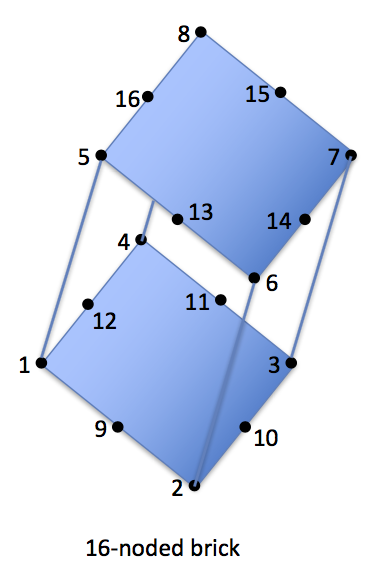
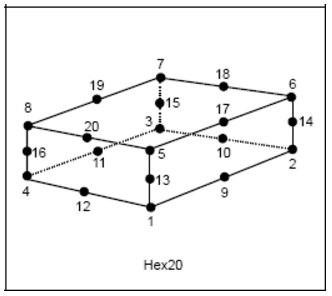
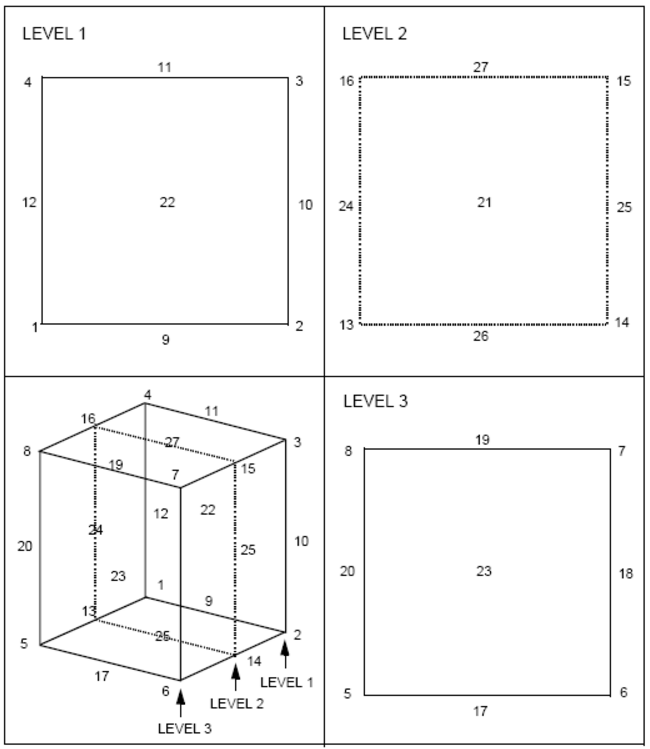
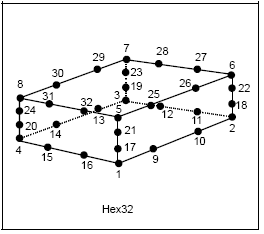
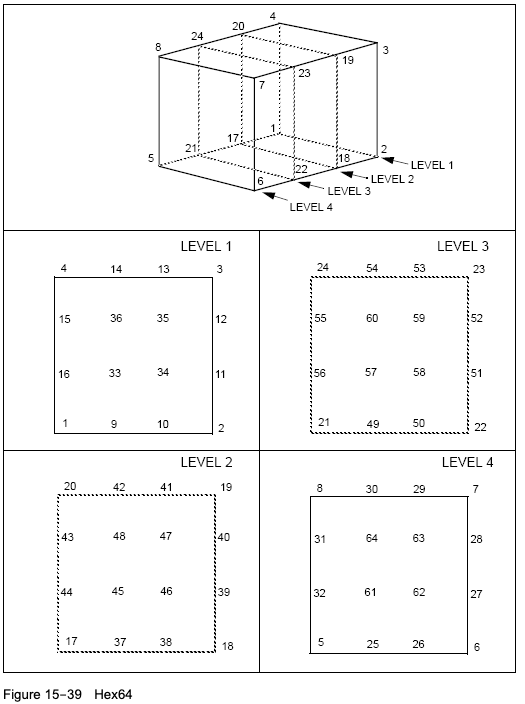
The side numbering for a hexahedral element type is shown below.
| Element Type | Side # | Node Order |
|---|---|---|
| HEX | 1 | 1, 2, 6, 5 |
| 2 | 2, 3, 7, 6 | |
| 3 | 3, 4, 8, 7 | |
| 4 | 1, 5, 8, 4 | |
| 5 | 1, 4, 3, 2 | |
| 6 | 5, 6, 7, 8 |
